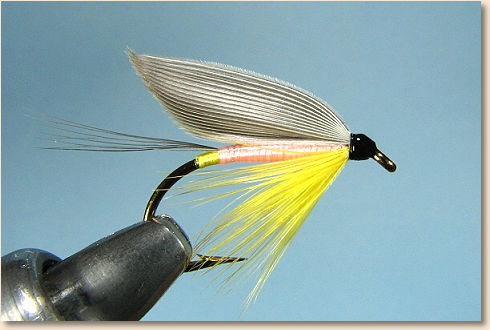I don't like to generalize but I think as a group most male
fly fishermen have a little bit of trouble with the idea of a
pink fly. I know I did when I was a teen in the Adirondacks in the '60s. Back
then we didn't have fly shops, we had bait shops, hardware stores, and
gas stations. Two flies that one would invariably see at Montgomery
Wards or the gas station/grocery store in Morrisonville by the Saranac River
were the Parmachene Belle and the Pink Lady. Thinking back on it now,
I would imagine these flies had been sitting there for years, holdovers
from the halcyon days of the brook trout. There was still considerable
brook trout fishing left back then too, and maybe that accounts for the
stocking of these. The Pink Lady was well known as a dry fly too, as well as
the Pink Bivisible. That said, there was always this feeling in the back of
your mind that you were fishing a girlie fly, and there was no small amount of
shame in doing so. It was for that reason more than any other that I quickly abandoned
the Pink Lady when it didn't produce for me the first couple of times, never to
return to it again.

If only I had known then what I know now. As it turns out, these pink bodied
flies were probably stocked because they were so effective. Anyone who's fished
a pink quill-bodied parachute for PMDs out West knows how successful they are,
and there is a whole stream of thought afoot today concerning Ultra Violet vision
where fish are concerned, with fluorescent pinks, chartreuse and other colors
exhibiting UV highlights. Czech nymphs are being tied with pink "hot spots" now,
and the pinkish "Tups" dubbing is making a comeback in the Catskills. So I will
add my failure to fish pink flies as a youth to my list of reasons why I went fishless
so much of the time back then. It's a very long list.
Lest I forget, there is one more pink fly which must be mentioned here. My friend
Fred Bridge from Pennsylvania has done a variation on the San Juan Worm that he calls
the "Infamous Pink Worm" that is one of those flies that is so effective it should
be considered bait and banned. I have been known to resort to it a time or two on our
Mad River here in Ohio when absolutely nothing was doing. It saved me from an otherwise
fishless day more than once. You can see Fred's fly and tying instructions here at:
Pink flies go way back, and here's a version of the old Wickham's Fancy called
the Pink Wickhams:

And finally, here are three more I've dug up, the Post, Perry, and Proctor flies, all
pretty in pink. I'll list all the recipes below.



Gray Coflin:
Pink Lady "Winged" (dry or wet):
Tip: Gold tinsel
Tail: Ginger hackle
Ribbing: Gold tinsel
Body: Pink floss
Hackle: Ginger
Wing: Slate
Pink Wickhams:
Post:
Perry:
Tip: Silver tinsel
Butt: Pink chenille
Body: Black chenille
Hackle: Black
Wing: Black, white tipped
Proctor:
Tip: Olive-brown chenille
Body: Pale pink chenille
Hackle: Brown
Wing: Mallard
Credits: Trout by Ray Bergman; Flies by J. Edson Leonard
~ EA
About Eric:
 Eric lives in Delaware, Ohio and fishes for brown trout in
the Mad River, a beautiful spring creek. More of his flies
are on display here:
Traditionalflies.com -- Classic salmon and
trout flies of Europe and the Americas.
Eric lives in Delaware, Ohio and fishes for brown trout in
the Mad River, a beautiful spring creek. More of his flies
are on display here:
Traditionalflies.com -- Classic salmon and
trout flies of Europe and the Americas.
|







 Eric lives in Delaware, Ohio and fishes for brown trout in
the Mad River, a beautiful spring creek. More of his flies
are on display here:
Traditionalflies.com -- Classic salmon and
trout flies of Europe and the Americas.
Eric lives in Delaware, Ohio and fishes for brown trout in
the Mad River, a beautiful spring creek. More of his flies
are on display here:
Traditionalflies.com -- Classic salmon and
trout flies of Europe and the Americas.